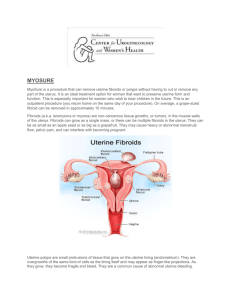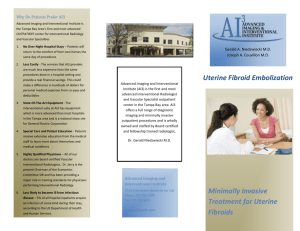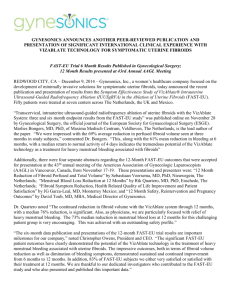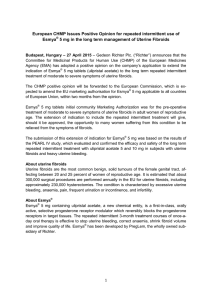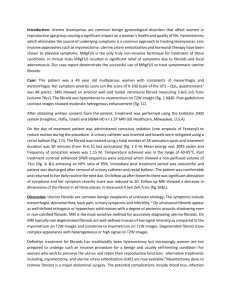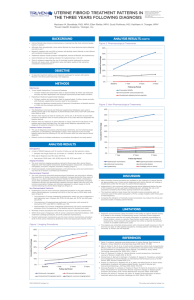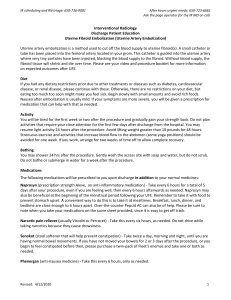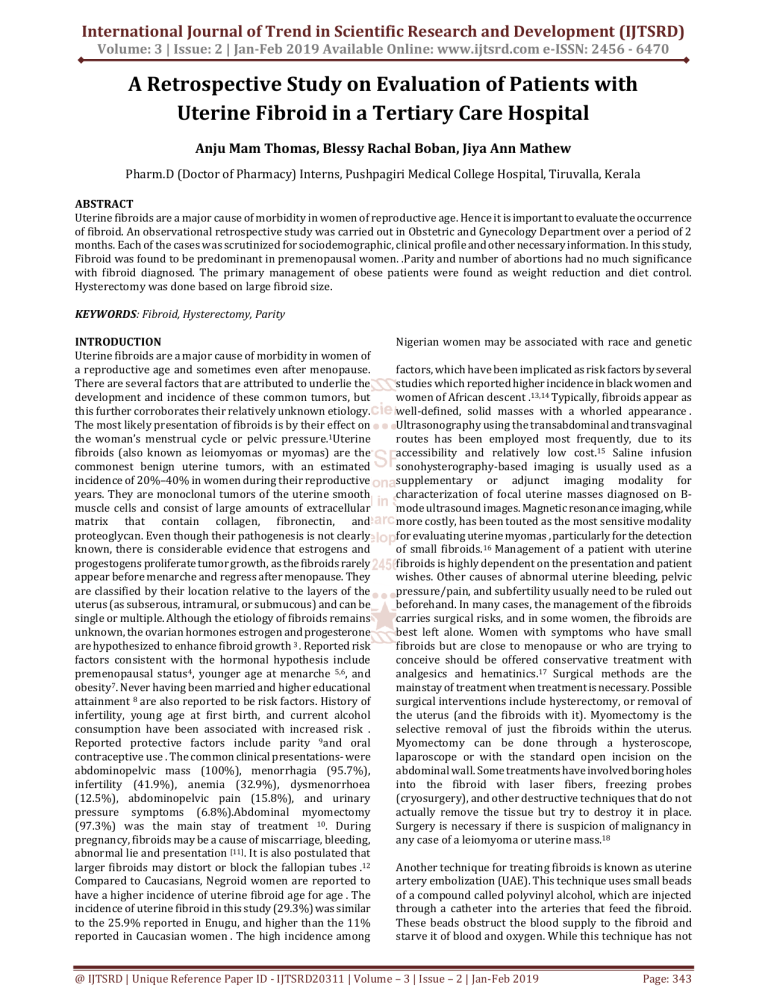
International Journal of Trend in Scientific Research and Development (IJTSRD)
Volume: 3 | Issue: 2 | Jan-Feb 2019 Available Online: www.ijtsrd.com e-ISSN: 2456 - 6470
A Retrospective Study on Evaluation of Patients with
Uterine Fibroid in a Tertiary Care Hospital
Anju Mam Thomas, Blessy Rachal Boban, Jiya Ann Mathew
Pharm.D (Doctor of Pharmacy) Interns, Pushpagiri Medical College Hospital, Tiruvalla, Kerala
ABSTRACT
Uterine fibroids are a major cause of morbidity in women of reproductive age. Hence it is important to evaluate the occurrence
of fibroid. An observational retrospective study was carried out in Obstetric and Gynecology Department over a period of 2
months. Each of the cases was scrutinized for sociodemographic, clinical profile and other necessary information. In this study,
Fibroid was found to be predominant in premenopausal women. .Parity and number of abortions had no much significance
with fibroid diagnosed. The primary management of obese patients were found as weight reduction and diet control.
Hysterectomy was done based on large fibroid size.
KEYWORDS: Fibroid, Hysterectomy, Parity
INTRODUCTION
Uterine fibroids are a major cause of morbidity in women of
a reproductive age and sometimes even after menopause.
There are several factors that are attributed to underlie the
development and incidence of these common tumors, but
this further corroborates their relatively unknown etiology.
The most likely presentation of fibroids is by their effect on
the woman’s menstrual cycle or pelvic pressure.1Uterine
fibroids (also known as leiomyomas or myomas) are the
commonest benign uterine tumors, with an estimated
incidence of 20%–40% in women during their reproductive
years. They are monoclonal tumors of the uterine smooth
muscle cells and consist of large amounts of extracellular
matrix that contain collagen, fibronectin, and
proteoglycan. Even though their pathogenesis is not clearly
known, there is considerable evidence that estrogens and
progestogens proliferate tumor growth, as the fibroids rarely
appear before menarche and regress after menopause. They
are classified by their location relative to the layers of the
uterus (as subserous, intramural, or submucous) and can be
single or multiple. Although the etiology of fibroids remains
unknown, the ovarian hormones estrogen and progesterone
are hypothesized to enhance fibroid growth 3 . Reported risk
factors consistent with the hormonal hypothesis include
premenopausal status4, younger age at menarche 5,6, and
obesity7. Never having been married and higher educational
attainment 8 are also reported to be risk factors. History of
infertility, young age at first birth, and current alcohol
consumption have been associated with increased risk .
Reported protective factors include parity 9and oral
contraceptive use . The common clinical presentations- were
abdominopelvic mass (100%), menorrhagia (95.7%),
infertility (41.9%), anemia (32.9%), dysmenorrhoea
(12.5%), abdominopelvic pain (15.8%), and urinary
pressure symptoms (6.8%).Abdominal myomectomy
(97.3%) was the main stay of treatment 10. During
pregnancy, fibroids may be a cause of miscarriage, bleeding,
abnormal lie and presentation [11]. It is also postulated that
larger fibroids may distort or block the fallopian tubes .12
Compared to Caucasians, Negroid women are reported to
have a higher incidence of uterine fibroid age for age . The
incidence of uterine fibroid in this study (29.3%) was similar
to the 25.9% reported in Enugu, and higher than the 11%
reported in Caucasian women . The high incidence among
Nigerian women may be associated with race and genetic
factors, which have been implicated as risk factors by several
studies which reported higher incidence in black women and
women of African descent .13,14 Typically, fibroids appear as
well-defined, solid masses with a whorled appearance .
Ultrasonography using the transabdominal and transvaginal
routes has been employed most frequently, due to its
accessibility and relatively low cost.15 Saline infusion
sonohysterography-based imaging is usually used as a
supplementary or adjunct imaging modality for
characterization of focal uterine masses diagnosed on Bmode ultrasound images. Magnetic resonance imaging, while
more costly, has been touted as the most sensitive modality
for evaluating uterine myomas , particularly for the detection
of small fibroids.16 Management of a patient with uterine
fibroids is highly dependent on the presentation and patient
wishes. Other causes of abnormal uterine bleeding, pelvic
pressure/pain, and subfertility usually need to be ruled out
beforehand. In many cases, the management of the fibroids
carries surgical risks, and in some women, the fibroids are
best left alone. Women with symptoms who have small
fibroids but are close to menopause or who are trying to
conceive should be offered conservative treatment with
analgesics and hematinics.17 Surgical methods are the
mainstay of treatment when treatment is necessary. Possible
surgical interventions include hysterectomy, or removal of
the uterus (and the fibroids with it). Myomectomy is the
selective removal of just the fibroids within the uterus.
Myomectomy can be done through a hysteroscope,
laparoscope or with the standard open incision on the
abdominal wall. Some treatments have involved boring holes
into the fibroid with laser fibers, freezing probes
(cryosurgery), and other destructive techniques that do not
actually remove the tissue but try to destroy it in place.
Surgery is necessary if there is suspicion of malignancy in
any case of a leiomyoma or uterine mass.18
Another technique for treating fibroids is known as uterine
artery embolization (UAE). This technique uses small beads
of a compound called polyvinyl alcohol, which are injected
through a catheter into the arteries that feed the fibroid.
These beads obstruct the blood supply to the fibroid and
starve it of blood and oxygen. While this technique has not
@ IJTSRD | Unique Reference Paper ID - IJTSRD20311 | Volume – 3 | Issue – 2 | Jan-Feb 2019
Page: 343
International Journal of Trend in Scientific Research and Development (IJTSRD) @ www.ijtsrd.com eISSN: 2456-6470
been in use long enough to evaluate long-term effects of UAE
versus surgery, it is known that women undergoing UAE for
fibroids have a shorter hospital stay than those having
surgery but a greater risk of complications and readmissions
to the hospital. Studies are underway to evaluate the longterm outcomes of UAE as opposed to surgical treatment.
Uterine artery occlusion (UAO), which involves clamping the
involved uterine arteries as opposed to injecting the
polyvinyl alcohol beads, is currently under investigation as a
potential alternative to UAE.
High-intensity focused ultrasound (HIFU) is a relatively new
treatment for fibroids and other abnormalities. It is also
known as MRgFUS (MRI-guided focused ultrasound) and FUS
(focused ultrasound surgery). HIFU uses an ultrasound
transducer with higher energy than those used for diagnostic
examinations. The device focuses the sound waves,
generating heat to destroy the fibroid. MRI imaging may be
used for planning and monitoring of treatment.Non-surgical
techniques are usually hormonal in nature and include the
use of drugs that turn off the production of estrogen from the
ovaries (GnRH analogs). These medications are given for
three to six months and induce a hypoestrogenic (low
estrogen) state. When successful, they can shrink the
fibroids by as much as 50%. Side effects of these drugs are
similar to the symptoms of menopause and can include hot
flashes, sleep disturbance, vaginal dryness, and mood
changes. Bone loss leading to osteoporosis after long-term (6
to 12+ months) use is one complication. This is generally
reversed after the treatment ends. These drugs may also be
used as preoperative treatment for large leiomyoma to
shrink them in order to make the operation less difficult and
reduce surgical risk.
Mifepristone (RU-486) is an antiprogestin drug that can
shrink fibroids to an extent comparable to treatment with
the GnRH analogs. This drug is also used to terminate early
pregnancy. Treatment with mifepristone also reduced the
bleeding associated with fibroids, but this treatment can be
associated with adverse side effects such as overgrowth
(hyperplasia) of the endometrium (uterine lining).
Mifepristone is not approved by the US Food and Drug
Administration (FDA) for the treatment of uterine
leiomyomas, and the required dosages (different from those
used for termination of early pregnancy) have not been
determined.
Danazol (Danocrine) is an androgenic steroid hormone that
has been used to reduce bleeding in women with fibroids,
since this drug causes menstruation to cease. However,
danazol does not appear to shrink the size of fibroids.
Danazol is also associated with significant side effects,
including weight gain, muscle cramps, decreased breast
size, acne, hirsutism (inappropriate hair growth), oily skin,
mood changes, depression, decreased high density
lipoprotein (HDL or 'good cholesterol') levels, and
increased liver enzyme levels.
with fibroids, but these do not shrink the fibroids
themselves.
MATERIALS AND METHODS
This was an observational retrospective study carried out in
Obstetric and Gynecology Department. over a period of 2
months. In this study a total of 20 cases with uterine fibroid
were enrolled during study period. The medical records of
all 20 cases of uterine fibroids managed during the period
were retrieved from the hospital medical record department
and retrospectively reviewed. Each of cases was scrutinized
for socio-demographic, clinical profile and other necessary
information. Data were expressed as number (percentage) in
tabular and graphical form. Appropriate statistical test was
applied. P value <0.05 was taken as level of significance and
data were entered and analyzed by MS excel-2014.
RESULTS
Out of total patients, 65% of patients belongs to the age
group 41-50; 25% of patients belongs to the age group 3040 and 10% of patients belongs to the age group greater
than 50 .
60% of the total population has undergone Full Term
Normal Delivery whereas the remaining 40% has
undergone Lower Segment Cesarean Section.
The administration of raloxifene (Evista), a drug used to
prevent and treat osteoporosis in postmenopausal women,
has been shown to decrease the size of fibroids in
postmenopausal women, but results with this therapy in
premenopausal women have been conflicting.
Low dose formulations of oral contraceptives are also
sometimes given to treat the abnormal bleeding associated
@ IJTSRD | Unique Reference Paper ID - IJTSRD20311 | Volume – 3 | Issue – 2 | Jan-Feb 2019
Page: 344
International Journal of Trend in Scientific Research and Development (IJTSRD) @ www.ijtsrd.com eISSN: 2456-6470
80% of total population has parity 2 whereas 15% has
parity 1 and the remaining 5%has parity 3.No nulliparity
has been observed.
60% of total population is not sterilised whereas 40% has
undergone sterilization.
81-90
1
5
65% of the women has weight range within 50-61 kg. only
5% of the women had overweight of greater than 81kg.
Treatment No. of cases Percentage
TAH+BSO
3
15
TAH
2
10
D&C
6
30
T. Meftal
4
20
Diet
1
5
30% of patients were recommended D&C, 20% with
Tablet Meftal 500mg, 10% with Total Abdominal
Hysterectomy, 15% with TAH+BSO and remaining 5%
with strict diet control.
CONCLUSION
Uterine fibroid is a common concern in women causing
heavy bleeding and pain symptoms which can have a
negative impact on different aspects in women's life.In this
study ,majority (65%) of the women population belongs to
41 -50 age group are found to have fibroid diagnosed.
Women having menarche at age greater than 16 years of age
was found to have less chance for fibroid. For overweight
patients, weight reduction and strict diet control were
proposed as the primary management. Majority of the
patients had symptoms of heavy menstrual bleeding and low
backache .45% of the total population had no past history of
dysmennorhea
etc.Fibroid was predominant
in
premenopausal women.Parity and number of abortions had
no much significance with fibroid diagnosed.
REFERENCE
[1] Rein MS, Barbieri RL, Friedman AJ. Progesterone: a
critical role in the pathogenesis of uterine myomas. Am
J Obstet Gynecol. 1995; 172(1 Pt1):14–18.
Majority of the population has no past history.15% had
D.M, 10% had dysmennorhea. Few patients had thyroid,
hypertension, bronchial asthma.
[2] Andersen J. Growth factors and cytokines in uterine
leiomyomas. Semin Reprod Endocrinol. 1996; 14(3):
269–282.
[3] Buttram VC, Reiter RC. Uterine leiomyomata: etiology,
symptomatology, and management. 1981, 36; 143-45.
[4] Marshall LM, Spiegelman D, Barbieri RL, et al. Variation
in the incidence of uterine leiomyoma among
premenopausal women by age and race. Obstet Gynecol
1997; 90:967–73.
[5] Samadi AR, Lee NC, Flanders WD, et al. Risk factors for
self-reported uterine fibroids: a case-control study. Am
J Public Healt 1996; 86:858–62
65% of total population has menarche within 13-15 years
of age, 30%has menarche at less than 12 years of age and
the remaining 5% has menarche at age greater than 16
years.
In our study, majority of the patients (50%) had lower
abdominal pain, (35%) had heavy menstrual bleeding and
25% had dysmennorhea. Only 3 patients had history of
abortion.45% of the total patients had multiple fibroids.35%
of patients had bulky uterus. The primary management
considered for obese patient was weight reduction.
Weight (kg) No.of cases Percentage
50-60
13
65
61-70
5
25
71-80
1
5
[6] Ross RK, Pike MC, Vessey MP, et al. Risk factors for
uterine fibroids: reduced risk associated with oral
contraceptives. Br Med J 1986;293:359–63
[7]
Michele R Forman,1 Lauren D Mangini,1 Rosenie
Thelus-Jean,2 and Mark D Hayward3 et al. Life-course
origins of the ages at menarche and menopause.
Adolesc Health Med Ther. 2013; 4: 1–21
[8] Marshall LM, Spiegelman D, Barbieri RL, et al. Variation
in the incidence of uterine leiomyoma among
premenopausal women by age and race. Obstet
Gynecol 1997;90:967–73.
[9] Parazzini F, Negri E, Vecchia CL, et al. Reproductive
factors and risk of uterine fibroids. Epidemiology 1996;
7:440.
@ IJTSRD | Unique Reference Paper ID - IJTSRD20311 | Volume – 3 | Issue – 2 | Jan-Feb 2019
Page: 345
International Journal of Trend in Scientific Research and Development (IJTSRD) @ www.ijtsrd.com eISSN: 2456-6470
[10] Atombosoba. A. Ekine1, Lucky O. Lawani2,
Chukwuemeka A. Iyoke3, Israel Jeremiah1, Isa. A.
Ibrahim1 Review of the Clinical Presentation of Uterine
Fibroid and the Effect of Therapeutic Interventi on
Fertility American Journal of Clinical Medicine
Research, 2015 3 (1) . pp 9-13
[11] Vollenhoven BJ, Lawrence AS and Healey DC (1990).
Uterine fibroid: a clinical review. British Journal of
Obstetrics and Gynaecology 1990: 97: 285-98
[12] Bendifallah, S., J. L. Brun, and H. Fernandez.
“[Myomectomy for infertile women: the role of
surgery].” J. Gynecol. Obstet. Biol. Reprod. (Paris) 40.8
(2011): 885-901.
[13] Ezugwu EC, Iyoke CA, Ezugwu FO, Ugwu G: Successful
pregnancy following myomectomy for giant uterine
fibroid in an infertile woman. J Reprod Infertil 2014,
15: 233-236.
[14] Fields KR, Neinstein LS. Uterine myomas in
adolescents: case reports and a review of the literature.
J Pediatr Adolesc Gynecol. 1996; 9(4):195-198.
[15] Levens ED, Wesley R, Premkumar A, Blocker W,
Nieman LK. Magnetic resonance imaging and
transvaginal ultrasound for determining fibroid
burden: implications for research and clinical care. Am
J Obstet Genecol. 2009; 200(5):537.
[16] Wise LA, Palmer JR, Harlow BL, et al. Reproductive
factors, hormonal contraception, and risk of uterine
leiomyomata
in
African-American
women:a
prospective study. Am J Epidemiol. 2004; 159(2):113–
123.
[17] Simms-Stewart D, Fletcher H. Counselling patients with
uterine fibroids: a review of the management and
complications. Obstet Gynecol Int. 2012;2012:539365
[18] www.medicinenet.com/uterine_fibroids/article.htm#u
terine_fibroids_definition_and_facts
@ IJTSRD | Unique Reference Paper ID - IJTSRD20311 | Volume – 3 | Issue – 2 | Jan-Feb 2019
Page: 346

